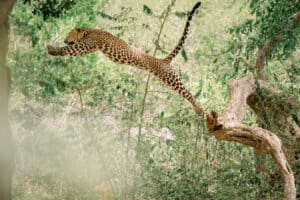New World monkeys are a diverse group of primates that don’t get as much attention as they deserve! We all know about gorillas, chimps, and orangutans, but primates in the Americas are just as interesting. Today, we will compare two of these primates to understand what makes them different. The spider monkey and the squirrel monkey are similar in that they are from the Americas, but they have a lot that makes them unique. Let’s discover: Spider Monkey vs Squirrel Monkey!
Comparing a Spider Monkey and a Squirrel Monkey
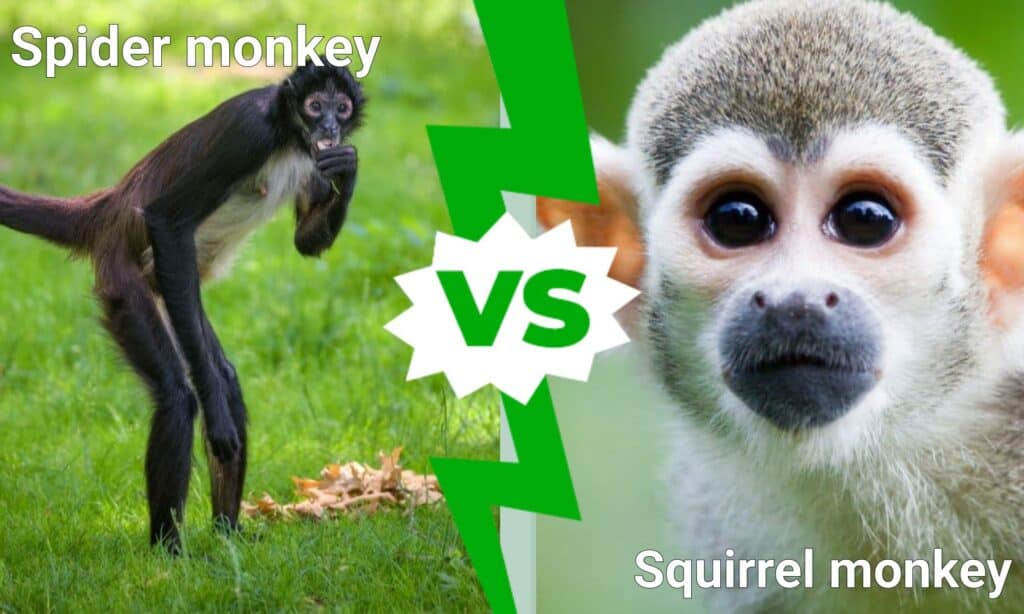
| Spider monkey | Squirrel monkey | |
|---|---|---|
| Size | Weight: Up to 26 lbs | Weight: 1.7-2.4 lbs |
| Appearance | Extremely long arms, legs, and tail. Colors depend on the species. | Small, miniature monkeys. Fur color depends on the species. |
| Tail | Extremely long prehensile tail. | Long non-prehensile tail. |
| Intelligence | Among the smartest of all primates, likely the result of diet. | Extremely intelligent, often used in testing. |
| Species | 7 species. | 5 species |
The 5 main differences between a spider monkey and a squirrel monkey
The main differences between a spider monkey and a squirrel monkey are size, the presence of a prehensile tail, and their appearance.
Although all monkeys have some similarities, there are often some rather notable differences between varying species. In the New World, there are a few specialized groups of monkeys that have evolved side, diverging millions of years ago. When it comes to spider and squirrel monkeys, the split happened quite a long time ago. These monkeys are quite different in appearance, size, and more.
There are seven species of spider monkey and five species of squirrel monkey. Although both have unique names associated with animals (spiders and squirrels), neither have any relation to their namesakes. Instead, they get their names from the appearances that they give when seen in the wild. Spider monkeys often hang upside down from trees by their tails and stretch out their long, spindly arms (like a spider). Squirrel monkeys are small in size and somewhat resemble a squirrel.
Aside from their evolutionary and namesake differences, there are a few other variations, including their size, tails, and intelligence. Let’s explore these in some more detail below!
Spider Monkey vs Squirrel Monkey: Size

Spider monkeys are significantly larger than squirrel monkeys.
©Nick Fox/Shutterstock.com
Regarding size, spider monkeys are significantly larger than squirrel monkeys. In fact, spider monkeys are among the largest species of primate in the New World. Most individuals reach 26 lbs, although some species can get a bit larger.
Squirrel monkeys, as their name would suggest, are incredibly small. These small primates usually measure less than a foot long (minus the tail) and weigh less than 2 lbs. Even with their size, they aren’t the smallest New World monkey, with that honor belonging to the marmoset and tamarin.
Spider Monkey vs Squirrel Monkey: Appearance
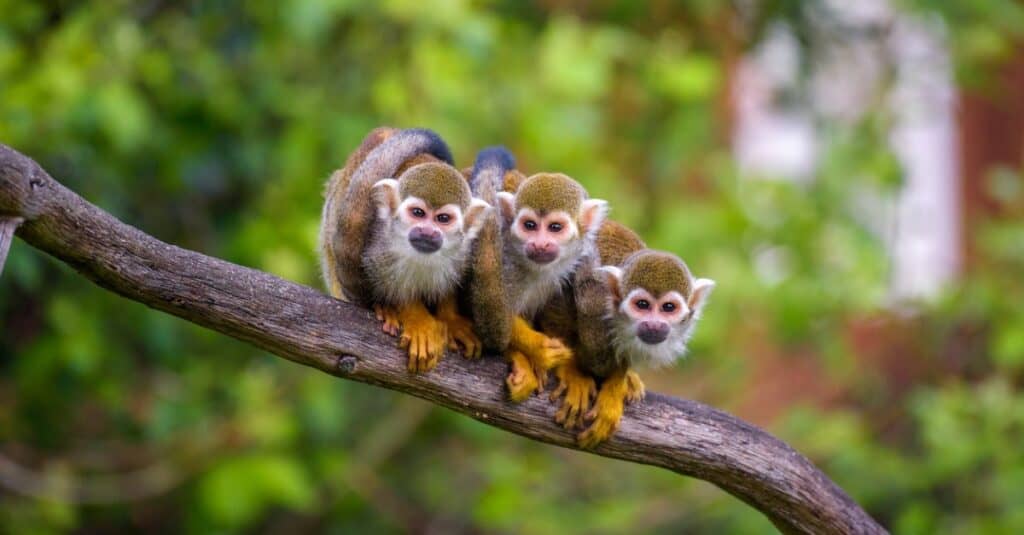
Squirrel monkeys are small and have white faces.
©iStock.com/miroslav_1
Squirrel monkeys are characterized by their small bodies, short fur, and long tails with a bushy end. Another notable characteristic is their black and white faces, giving them their nickname, the “death’s head” monkey.
Spider monkeys are known for their extremely long and spindly arms paired with a long prehensile tail. These long arms are what inspired the monkeys’ name in the first place. There are a few different species of spider monkey, all with their unique fur colorations. Generally, spider monkeys have dark backs with lighter-colored bellies.
Spider Monkey vs Squirrel Monkey: Tail
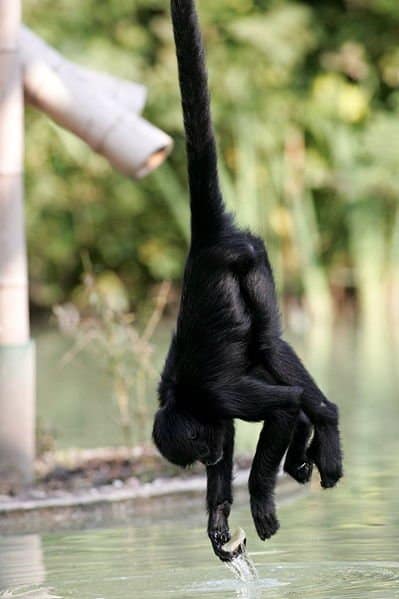
Spider monkeys have long prehensile tails that can be used to hang on things.
The spider monkey, along with most New World monkeys, has what’s known as prehensile tails. Prehensile tails are tails that are adapted to grasp or hold onto objects. In the case of the spider monkey, these tails are used to hang from tree branches as they climb and search for food.
Squirrel monkeys don’t have prehensile tails. Instead of using their tails to grasp things, squirrel monkeys use them as a counterbalance to help them move along thin branches faster. Essentially, they act as a pendulum, helping them to keep balance.
Spider Monkey vs Squirrel Monkey: Intelligence
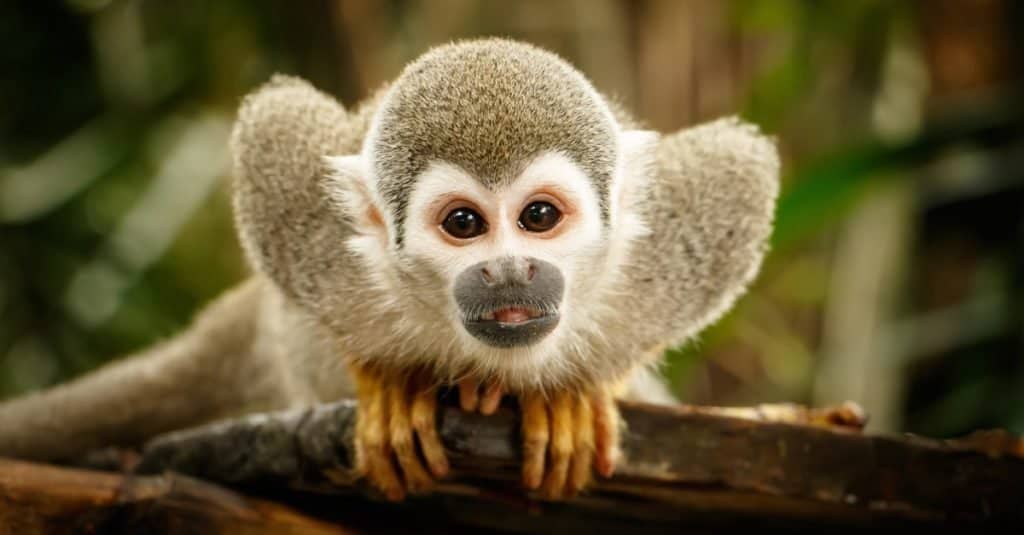
Both monkeys are extremely intelligent and among the smartest in the animal kingdom.
©Ludmila Ruzickova/Shutterstock.com
Almost all primates have a high level of intelligence, but spider monkeys are among the top of the entire list. It was originally thought that New World primates weren’t as intelligent as Old World primates, but new data may say otherwise. Recent studies show that spider monkeys may even be the smartest of all the New World monkeys, unseating the previously held champion, the capuchin monkey.
Although spider monkeys are among the smartest in the New World, squirrel monkeys are also incredibly intelligent. In fact, squirrel monkeys have the highest brain-to-body ratio of any non-human primate in the New World. Their size and intellect have made them perfect test subjects in human experimentation, with an individual named Miss Baker even heading to space as a part of a United States space mission!
Spider Monkey vs Squirrel Monkey: Species
Spider monkeys:
- Genus Ateles: spider monkeys
- Red-faced spider monkey, Ateles paniscus
- White-fronted spider monkey, Ateles belzebuth
- Peruvian spider monkey, Ateles chamek
- Brown spider monkey, Ateles hybridus
- White-cheeked spider monkey, Ateles marginatus
- Black-headed spider monkey, Ateles fusciceps
- Brown-headed spider monkey, Ateles fusciceps fusciceps
- Colombian spider monkey, Ateles fusciceps rufiventris
- Geoffroy’s spider monkey, Ateles geoffroyi
- Hooded spider monkey Ateles geoffroyi grisescens
- Yucatan spider monkey, Ateles geoffroyi yucatanensis
- Mexican spider monkey, Ateles geoffroyi vellerosus
- Nicaraguan spider monkey, Ateles geoffroyi geoffroyi
- Ornate spider monkey, Ateles geoffroyi ornatus
Squirrel monkeys:
Genus Saimiri
- S. sciureus group
- Central American squirrel monkey, Saimiri oerstedii
- Black-crowned Central American squirrel monkey, Saimiri oerstedii oerstedii
- Grey-crowned Central American squirrel monkey, Saimiri oerstedii citrinellus
- Common squirrel monkey, Saimiri sciureus
- Saimiri sciureus sciureus
- Saimiri sciureus albigena
- Humboldt’s squirrel monkey, Saimiri sciureus cassiquiarensis
- Ecuadorian squirrel monkey, Saimiri sciureus macrodon
- Bare-eared squirrel monkey, Saimiri ustus
- Central American squirrel monkey, Saimiri oerstedii
- S. boliviensis group
- Black-capped squirrel monkey, Saimiri boliviensis
- Bolivian squirrel monkey, Saimiri boliviensis boliviensis
- Peruvian squirrel monkey, Saimiri boliviensis peruviensis
- Black squirrel monkey, Saimiri vanzolinii
- Black-capped squirrel monkey, Saimiri boliviensis
The photo featured at the top of this post is © l i g h t p o e t/Shutterstock.com
Thank you for reading! Have some feedback for us? Contact the AZ Animals editorial team.




